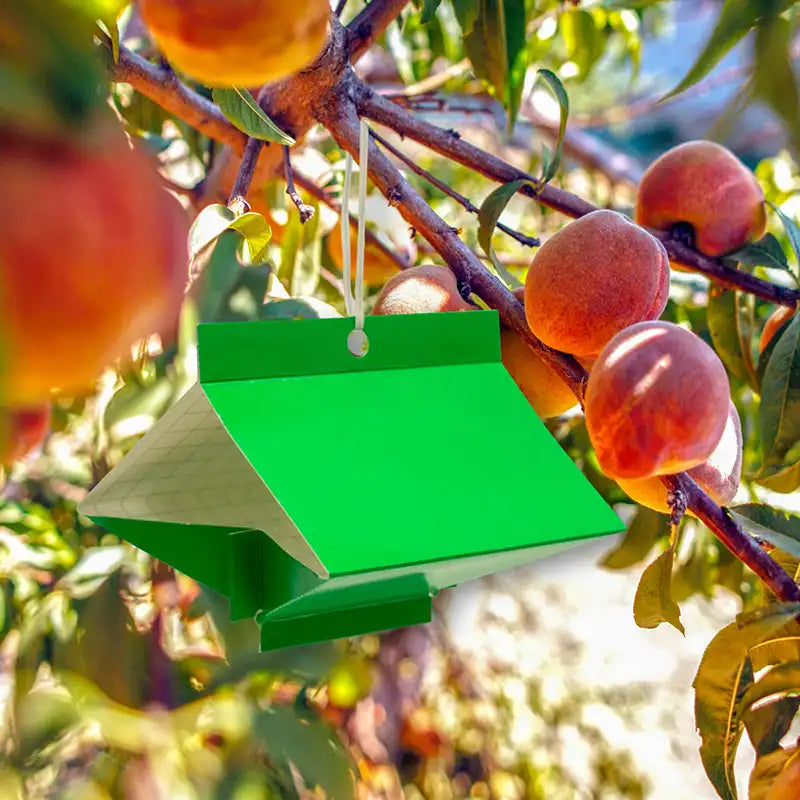Peach Tree Borers and other Un-peachy Realities
Peach Tree Borers and other Un-peachy Realities
Q. I have a four year old peach tree with a heavy presence of a jelly like substance on the branches and around the base. Cause? Cure?
---"C. R." in West Chester, PA
A. Sounds like both kinds of peach tree borers. The so-called 'lesser peach tree borer' does damage up in the canopy. The just plain 'peach tree borer' does its dirty work down at the base of the tree, anywhere from three inches below the soil line to about a foot above. The 'jelly' is a mixture of tree sap, their poop and some sawdust from the holes the larvae dig into the tree bark.
I am furious with these creatures—they are decimating my wife's peach trees! I started with ten trees 12 years ago. Over the years I cut down three "healthy" ones because no matter what I did, the little peaches never made it to ripeness. And I took another one down because it turned out to be some weird kind of ornamental with beautiful red leaves.
(Yes; it was lovely! But lovely is for roses; peaches are for fruit—and this thing never made any.)
Then there were six…
And now I'm down to four, because two died suddenly last summer. (How Tennessee Williams of them…)
Borers have certainly attacked the trees (I've seen small-to-medium signs of borer damage on almost every tree over the years), but I'm not certain they're the cause of demise of the ones I've lost. I do know for a fact that the adult female borer is a dark metallic blue, day-flying moth with transparent wings, a bright orange band across its back and the long antennae typical of these wood-drilling pests because I captured one over the summer.
(And the Geneva Convention does not apply to insects. 'Nuff said.)
Now; what could I—and other peach growers—have done or do to prevent borer and other damage?
It turns out that peach care is even more complex than I thought—and I knew it was pretty darn complex! I was already pruning every spring, thinning the developing fruits and spraying clay on the trees to prevent problems like brown rot and insects that directly attack the fruits. And I knew about these bark-drilling pests, but figured that healthy trees growing organically could take a little bit of borer damage. And maybe they could; but there was something else I didn't know; something our resident fruit expert Dr. Lee Reich recently smartened me up about.
(Twelve years too late.)
Anyway, I knew to protect young trees from deer, and for this purpose I used expandable plastic wrap-around tree guards every winter; which just happened to be white in color. But once the trees were four or five years old and no longer a target of those giant stomachs with legs, I stopped—and the author of "Grow Fruit Naturally" explains that that put me at the mercy of winter.
Now don't get me wrong—peach trees love the cold. They even require a certain number of 'chilling hours' to produce fruit. What they don't like is roller-coaster winters. Lee explains that peaches are native to parts of China where winter stays cold. But our winters, which love to mood-swing between warm and cold can cause the bark to expand and contract and eventually split. Those splits weaken the trees, which makes them more attractive to borers and provides an opening for canker, a bacterial disease that also makes the trees ooze jelly. I just noticed that the bark had split on some of my trees last season.
Lee explains that I should have started painting the trunks white over the winter to reflect the sun on bright days after I stopped using the white tree guards, which had accidentally performed the same function (a lot of my gardening success involves accidents). Lee says to use a 50/50 mix of white Latex paint and water. He adds that he mixes strong scents like garlic and deer repellant into the paint to try and also deter borers.
Now—to put my seeming failure in perspective, I have apparently harvested a gazillion times more fruit than Dr. Lee, who, in his behalf, has always said that he loves to grow peach trees simply as ornamentals. (He and I both agree that the blossoms are drop-dead gorgeous, and the bark is four-season attractive.) Along with all the bad news, he told me that he's happy if he gets a nice crop of actual peaches every four or five years. Which makes me feel much better, as I've harvested a ton of peaches every year since our trees were around three years old.
And Lee adds that even without being attacked, peach trees only live about 15 years—so mine were aging out anyway. AND there's also a syndrome called "Peach Tree Short Life" (PTSF) where trees suddenly wilt and die when they're between three and six years old (mostly, it seems, due to that winter bark split stress). The two I just lost to those symptoms were much older than that; and, again, we got a ton of peaches off of both of them for many years; so I have clearly been doing a lot of things right.
You know, I think this explains why my radio show gets so many phone calls about people buying a property that has really old apple trees, but we have never gotten a call about a 'majestic old peach'. For peach trees, a decade and a half is 'old'!
(Getting a steady supply of peaches over a long period of time (as in decades) is apparently a lot like voting in a Philly election; you should plant early and often.)
So—based on all that I've recently learned and already knew, here are my new and much more complete rules for peach tree care:
• Be sure to plant new trees really high in the ground, so that the entire root flare is visible; and keep that area clear of mulch. Borers are attracted to deeply planted and 'volcano mulched' trees.
• Protect young trees from deer every winter with tree guards or wire cages.
• Paint the trunks white every winter to prevent bark splitting.
• Consider adding a strong scented substance to the paint mixture to deter borers.
• Feed the trees with a mulch of compost and/or worm castings every Spring to keep them naturally well-fed and healthy.
• Prune them heavily every year, just as they begin to flower.
• Then hang peach tree borer traps in the area--both to alert you when the adult moths are ready to lay eggs and to knock their numbers down.
• Remove half to three-quarters of the developing fruits while they're still small.
• Spray regularly over the growing season with a micronized clay preparation like Surround to deter disease and insects that attack the actual fruits, like the plum curculio.
• Consider spraying the lower area of the tree with the old original form of Bt (BTK) beginning in early summer to kill any little borers before they can drill too deeply into the bark. (They're caterpillars, and BTK is deadly to caterpillars—while harming no other forms of life.)
• If you use traps, begin to spray BTK down low as soon as you catch your first moth.
• Investigate any areas of 'peach jelly'. If there's a little hole in the bark, jab a wire or paper clip in there to kill the borer. Call it a bad name as you probe.
• Consider planting 'runs' of trees. For instance, instead of planting ten or twelve trees all at once (like I did), plant three new trees every five or six years, being aware that even with the best care, each tree is going to max out at around age 15. (Like I did.)
• Oh—and it turns out that peach trees prefer a slightly alkaline soil—the reverse of popular plants like blueberries, azalea, and rhododendron. And soils in areas of high rainfall—like my personal Pennsylvania—tend to be acidic, which is, of course, the opposite of alkaline. So I just dusted the soil around my remaining trees with some wood ash from our fireplace.
And finally, don't let this scare you off. Although we've clearly had some issues with our trees over the years, we have harvested hundreds of pounds of fresh peaches, despite missing out on at least one critical aspect of their care (preventing the bark from splitting over winter). And we still have four trees left; and quite honestly, four trees will produce about as much as we can eat.
So relax and yes, plant peach trees. Give them the best care you can, and you will be awash in the most insanely delectable fresh fruit you can grow.
Q. I have a four year old peach tree with a heavy presence of a jelly like substance on the branches and around the base. Cause? Cure?
---"C. R." in West Chester, PA
A. Sounds like both kinds of peach tree borers. The so-called 'lesser peach tree borer' does damage up in the canopy. The just plain 'peach tree borer' does its dirty work down at the base of the tree, anywhere from three inches below the soil line to about a foot above. The 'jelly' is a mixture of tree sap, their poop and some sawdust from the holes the larvae dig into the tree bark.
I am furious with these creatures—they are decimating my wife's peach trees! I started with ten trees 12 years ago. Over the years I cut down three "healthy" ones because no matter what I did, the little peaches never made it to ripeness. And I took another one down because it turned out to be some weird kind of ornamental with beautiful red leaves.
(Yes; it was lovely! But lovely is for roses; peaches are for fruit—and this thing never made any.)
Then there were six…
And now I'm down to four, because two died suddenly last summer. (How Tennessee Williams of them…)
Borers have certainly attacked the trees (I've seen small-to-medium signs of borer damage on almost every tree over the years), but I'm not certain they're the cause of demise of the ones I've lost. I do know for a fact that the adult female borer is a dark metallic blue, day-flying moth with transparent wings, a bright orange band across its back and the long antennae typical of these wood-drilling pests because I captured one over the summer.
(And the Geneva Convention does not apply to insects. 'Nuff said.)
Now; what could I—and other peach growers—have done or do to prevent borer and other damage?
It turns out that peach care is even more complex than I thought—and I knew it was pretty darn complex! I was already pruning every spring, thinning the developing fruits and spraying clay on the trees to prevent problems like brown rot and insects that directly attack the fruits. And I knew about these bark-drilling pests, but figured that healthy trees growing organically could take a little bit of borer damage. And maybe they could; but there was something else I didn't know; something our resident fruit expert Dr. Lee Reich recently smartened me up about.
(Twelve years too late.)
Anyway, I knew to protect young trees from deer, and for this purpose I used expandable plastic wrap-around tree guards every winter; which just happened to be white in color. But once the trees were four or five years old and no longer a target of those giant stomachs with legs, I stopped—and the author of "Grow Fruit Naturally" explains that that put me at the mercy of winter.
Now don't get me wrong—peach trees love the cold. They even require a certain number of 'chilling hours' to produce fruit. What they don't like is roller-coaster winters. Lee explains that peaches are native to parts of China where winter stays cold. But our winters, which love to mood-swing between warm and cold can cause the bark to expand and contract and eventually split. Those splits weaken the trees, which makes them more attractive to borers and provides an opening for canker, a bacterial disease that also makes the trees ooze jelly. I just noticed that the bark had split on some of my trees last season.
Lee explains that I should have started painting the trunks white over the winter to reflect the sun on bright days after I stopped using the white tree guards, which had accidentally performed the same function (a lot of my gardening success involves accidents). Lee says to use a 50/50 mix of white Latex paint and water. He adds that he mixes strong scents like garlic and deer repellant into the paint to try and also deter borers.
Now—to put my seeming failure in perspective, I have apparently harvested a gazillion times more fruit than Dr. Lee, who, in his behalf, has always said that he loves to grow peach trees simply as ornamentals. (He and I both agree that the blossoms are drop-dead gorgeous, and the bark is four-season attractive.) Along with all the bad news, he told me that he's happy if he gets a nice crop of actual peaches every four or five years. Which makes me feel much better, as I've harvested a ton of peaches every year since our trees were around three years old.
And Lee adds that even without being attacked, peach trees only live about 15 years—so mine were aging out anyway. AND there's also a syndrome called "Peach Tree Short Life" (PTSF) where trees suddenly wilt and die when they're between three and six years old (mostly, it seems, due to that winter bark split stress). The two I just lost to those symptoms were much older than that; and, again, we got a ton of peaches off of both of them for many years; so I have clearly been doing a lot of things right.
You know, I think this explains why my radio show gets so many phone calls about people buying a property that has really old apple trees, but we have never gotten a call about a 'majestic old peach'. For peach trees, a decade and a half is 'old'!
(Getting a steady supply of peaches over a long period of time (as in decades) is apparently a lot like voting in a Philly election; you should plant early and often.)
So—based on all that I've recently learned and already knew, here are my new and much more complete rules for peach tree care:
• Be sure to plant new trees really high in the ground, so that the entire root flare is visible; and keep that area clear of mulch. Borers are attracted to deeply planted and 'volcano mulched' trees.
• Protect young trees from deer every winter with tree guards or wire cages.
• Paint the trunks white every winter to prevent bark splitting.
• Consider adding a strong scented substance to the paint mixture to deter borers.
• Feed the trees with a mulch of compost and/or worm castings every Spring to keep them naturally well-fed and healthy.
• Prune them heavily every year, just as they begin to flower.
• Then hang peach tree borer traps in the area--both to alert you when the adult moths are ready to lay eggs and to knock their numbers down.
• Remove half to three-quarters of the developing fruits while they're still small.
• Spray regularly over the growing season with a micronized clay preparation like Surround to deter disease and insects that attack the actual fruits, like the plum curculio.
• Consider spraying the lower area of the tree with the old original form of Bt (BTK) beginning in early summer to kill any little borers before they can drill too deeply into the bark. (They're caterpillars, and BTK is deadly to caterpillars—while harming no other forms of life.)
• If you use traps, begin to spray BTK down low as soon as you catch your first moth.
• Investigate any areas of 'peach jelly'. If there's a little hole in the bark, jab a wire or paper clip in there to kill the borer. Call it a bad name as you probe.
• Consider planting 'runs' of trees. For instance, instead of planting ten or twelve trees all at once (like I did), plant three new trees every five or six years, being aware that even with the best care, each tree is going to max out at around age 15. (Like I did.)
• Oh—and it turns out that peach trees prefer a slightly alkaline soil—the reverse of popular plants like blueberries, azalea, and rhododendron. And soils in areas of high rainfall—like my personal Pennsylvania—tend to be acidic, which is, of course, the opposite of alkaline. So I just dusted the soil around my remaining trees with some wood ash from our fireplace.
And finally, don't let this scare you off. Although we've clearly had some issues with our trees over the years, we have harvested hundreds of pounds of fresh peaches, despite missing out on at least one critical aspect of their care (preventing the bark from splitting over winter). And we still have four trees left; and quite honestly, four trees will produce about as much as we can eat.
So relax and yes, plant peach trees. Give them the best care you can, and you will be awash in the most insanely delectable fresh fruit you can grow.


